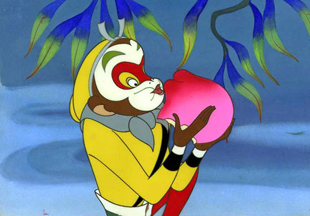| Home / Film in China / latest | Tools: Save | Print | E-mail | Most Read |
| Chinese Cartoons Face Talent, Market Issues |
| Adjust font size: |
When we think of famous Chinese animation films, most young adults think of "The Monkey King," "Little Tadpole Looking for Mom" and other impressive films. But when we try to think of other quality cartoons, those made after the late 1980s and even today, we draw a blank. That's because there were and still are few quality animation films and Chinese industry is immature. Plots and characters are generally uninteresting, creativity is low, and there are few new talents and veterans to guide them. The market is flooded by foreign cartoons, Chinese producers copy foreign ideas and don't have a clue about promotion, marketing and product spin-offs. Where to begin? The best minds in the animation business are working on the problem. It has already been 80 years ever since the appearance of the first Chinese animation film - "Danao Huashi," or "Mischief-making in the Art Gallery" in 1926.
When we think of famous Chinese animation films, most young adults think of "The Monkey King" and other impressive films. But when we try to think of other quality cartoons, those made after the late 1980s and even today, we draw a blank. To mark the anniversary of Chinese animation films, the Oriental Rostrum reviewed the development - and problems - of the film industry over the eight decades. It grew rapidly after the founding of the People's Republic of China in 1949, especially after the mid-1950s, but the 10 years of "cultural revolution" (1966-1976) was devastating for all the art forms. The famous "Monkey King," produced by the Shanghai Animation Film Studio from 1961 to 1964, is the world's most popular Chinese animation film. By 1984, the cartoon had been shown in 44 countries and regions. However, as China gradually opened its market, the influx of foreign animation films disrupted the domestic industry which was not accustomed to competition. Chinese audiences preferred foreign animation and, as a result, very few quality domestic animation films were produced during the 1990s. That was especially so after 1993 when China opened its animation film industry to the outside world. Problems for the animation industry arose during China's transition from a planned economy to a market economy. Yan Dingxian, former president of Shanghai Animation Film Studio, said that before the reform and opening up that studio was the only one in China to produce cartoon films. The former China Film Distribution and Exhibition Corp bought all the films and broadcast them, regardless of the quality. Filmmakers didn't have to be competitive - and their films definitely could not compete. Nowadays, since China's opening up, animation films must compete with foreign animation films on an equal footing. Today the industry faces problems of finding good scripts and nurturing young talents. "Besides, TV stations nowadays offer very low prices to purchase animation films," says Yan. It usually costs 10,000 yuan (US$1,279) to produce one minute's film, but even the highest offer, usually from China Central Television, is only several hundred yuan for one minute. That means those who rely only on animation for a living cannot survive, discouraging many who want to make it their profession. Challenges But capital isn't such a big problem today because of government subsidies and tax breaks to film animation companies, said Wang Tianyun, vice president of Shanghai Film Group Corp. The bigger problem is lack of good animation plays and the need to build an entire industrial chain of animation films. Yan agrees with Wang. "From the late 1960s to the reform and opening up, there was no cultivation of artistic talents," he said. That has led to a lack of experienced talent in animation films today, he said. Although more and more university students are graduating in the arts, film and design, they lack experience. Further, nowadays people are too eager for instant success and quick profits to make quality animation films, said Yan. Yan said the cartoon market is still immature in China. Producers don't pay enough attention to promotion of their cartoons as well as marketing spin-offs of cartoon characters and related items - foreign producers are particularly skilled at this kind of marketing. Statistics show that in general a successful cartoon makes two-thirds of its money through cartoon-derivative products rather than screening of the film itself. Both Yan and Wang cited lack of creativity. "Cartoons nowadays lack Chinese national features. They imitate foreign cartoons too much," said Wang. But Hu Zhaohong, director and cameraman of the Shanghai Animation Film Studio, said the industry should have a broader definition of "culture with national features". What's important now, he said, is whether Chinese producers are playing a dominant role in making cartoons. "We agree that traditional Chinese cartoons such as 'Little Tadpole Looking for Mom,' and 'The Cowboy's Flute' are good. But if we continue to produce such cartoons, people will surely find them out of date," said Hu. He said each animation film should clearly position itself for its audience but the industry as a whole should appeal to people of all ages. Film output reached 47,200 minutes in 2005, compared with an average of 4,700 minutes per year from 1993 to 2003, according Xinhua News Agency. But of course, it is quality that matters. Hopefully, with the support of the government and efforts of older and younger animators, the future of the film industry will be promising. (Shanghai Daily December 25, 2006)
|
| Tools: Save | Print | E-mail | Most Read |
 |
| Related Stories |
